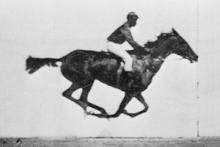

Lead refers to which set of legs, left or right, leads or advances forward to a greater extent when a quadruped animal is cantering, galloping, or leaping. The feet on the leading side touch the ground forward of its partner. On the "left lead", the animal's left legs lead. The choice of lead is of special interest in horse riding.
A lead change refers to an animal, usually a horse, moving in a canter or gallop, changing from one lead to the other. There are two basic forms of lead change: simple and flying. It is very easy to define the correct lead from the incorrect lead. When a horse is executing the correct lead, the inside front and hind legs reach farther forward than the outside legs.
In a transverse or lateral or united canter and gallop, the hind leg on the same side as the leading foreleg (the lateral hindleg) advances more.[1] In horses this is the norm.
In a rotatory or diagonal or disunited canter and gallop, the hind leg on the opposite side (the diagonal hindleg) advances more.[1] In horses, it is more often than not an undesirable gait form, also known as rotary and round galloping, and as moving disunited, cross-firing, and cross-cantering. In animals such as dogs, deer, and elk, however, this form of the gait is the norm.[1]
Some authorities define the leading leg in the singular form as the last to leave the ground before the one or two periods of suspension within each stride.[2] In these cases, because the canter has only one moment of suspension, the leading leg is considered to be the foreleg. Because in some animals the gallop has two moments of suspension, some authorities recognize a lead in each pair of legs, fore and hind. So when an animal is in a rotatory gait, it is called disunited,[2] due to different leading legs in the front and hind.